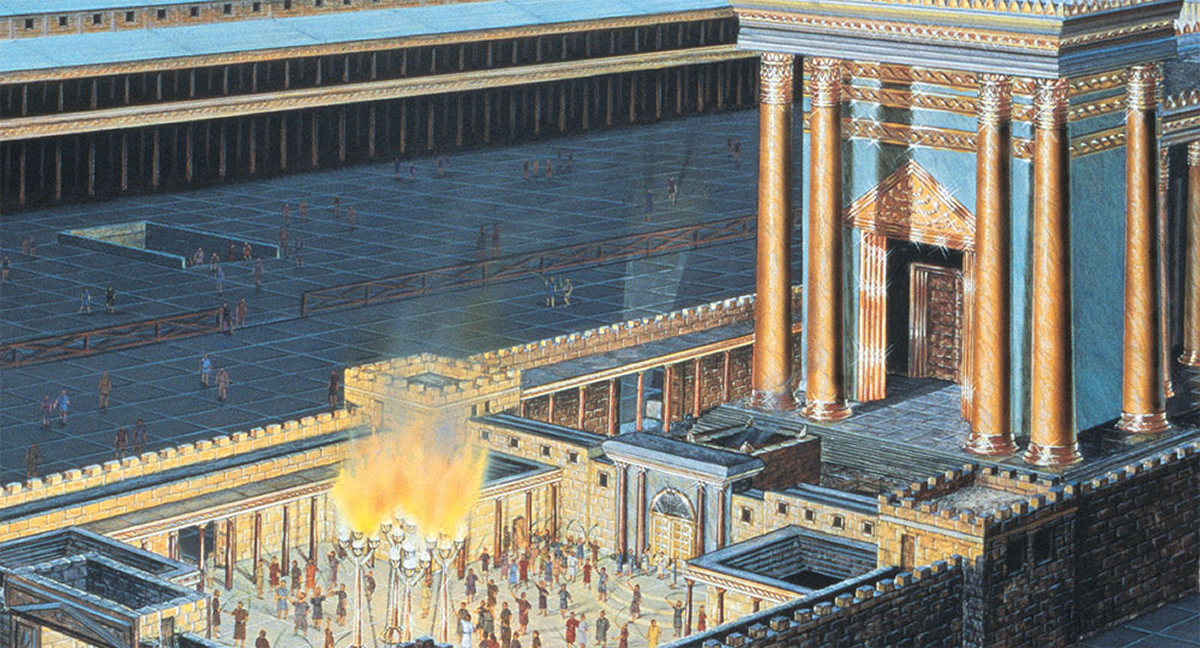At the close of the first day of the feast, the worshippers descended to the Court of the Women, where elaborate preparations had been made. Four golden candelabras stood there, each with four golden bowls, supported by four ladders. Four youths of priestly descent each held a pitcher of oil, capable of holding 120 log, from which they filled each bowl. The old, worn breeches and girdles of the priests served as wicks for these lamps. There was not a courtyard in Jerusalem that was not illuminated by the light of the “House of Water-Pouring.” The Chassidim and “Men of Deed” danced before the people with flaming torches in their hands, singing hymns and songs of praise. The Levites, with harps, lutes, cymbals, trumpets, and countless other musical instruments, stood upon the fifteen steps leading from the Court of Israel to the Court of the Women, corresponding to the fifteen Songs of Ascents in the Book of Psalms. They played their instruments and sang hymns. Two priests with trumpets stood at the upper gate (the Gate of Nicanor), which led from the Court of Israel to the Court of the Women. At cockcrow, they sounded a threefold blast. As they reached the tenth step, they sounded another threefold blast; upon entering the court itself, they sounded yet another threefold blast. They continued to blow their trumpets as they advanced until they reached the eastern gate (the Beautiful Gate). Upon arriving at the eastern gate, they turned toward the west (to face the Holy Place) and declared: “Our fathers who were in this place turned their backs upon the Sanctuary of Jehovah, their faces toward the east, worshipping the rising sun; but as for us, our eyes are toward the Lord.”
From The Temple: Its Ministry and Services Alfred Edersheim (1825–1889), Chapter 14
Thus, the entire city of Jerusalem was ablaze with light—a true city set on a hill.
The illumination served as a reminder of the Shekinah Glory, the divine light of God that filled Solomon’s Temple at its dedication during the Feast of Tabernacles (2 Chronicles 7:1–3): “When Solomon finished praying, fire came down from heaven and consumed the burnt offering and the sacrifices, and the glory of the Lord filled the temple. The priests could not enter the temple of the Lord because the glory of the Lord filled it. When all the Israelites saw the fire coming down and the glory of the Lord above the temple, they knelt on the pavement with their faces to the ground, and they worshiped and gave thanks to the Lord, saying, ‘He is good; his love endures forever.’”
This light also symbolized divine revelation, pointing to a time when God Himself will be the only true light. It fulfilled Isaiah’s prophecy: Isaiah 9:2 – “The people walking in darkness have seen a great light; on those living in the land of the shadow of death, a light has dawned.”
Yet, all of this was merely a foreshadowing of the true light already present among them during a particular Feast of Tabernacles. It was during this feast that Jesus proclaimed: John 8:12 – “I am the light of the world. Whoever follows me will never walk in darkness, but will have the light of life.”
Remarkably, though many of these practices were not mandated by Scripture but were traditions of the people, Jesus demonstrated how He fulfilled even their traditions.
© 2025 B Arnold Stein

Leave a Reply